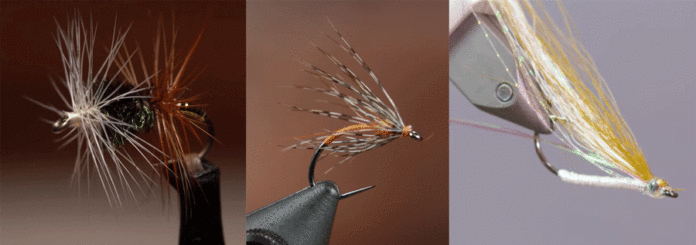Written by: Evan Jones
Fall fishing often requires a more technical approach, as water levels drop and hatches become smaller and scarcer. While these conditions may not typically bring to mind the clunky old classics, a few old-school fly patterns still manage to excel when conditions get tough. Here are three of the best, along with some potential modification tips to bring them into the 21st century.
Renegade
A few decades ago, this unassuming wad of peacock herl bookended by brown and grizzly hackles could be found in just about every fly box across the country. Usually tied far too large, and not closely resembling anything, it’s not surprising that this pattern was eventually replaced with more complex imitations. But the Renegade’s simplicity and generic “suggestive” appearance is precisely why it still deserves a spot in your fly box. Not only can it pass for a variety of insects, but it rides lower in the film compared to similar patterns, such as the Griffith’s Gnat, which helps it draw more strikes from hesitant fish in low, clear water. Modernize this pattern by downsizing to a size 18 and/or substituting Ice Dub for the peacock herl.
Renegade
Hook: Standard dry-fly hook (here, a Dai-Riki #300), sizes 12-18.
Thread: Cream, 8/0 or 70-denier.
Tag: Gold/silver Mylar Tinsel, extra-small.
Rear hackle: Brown.
Body: Peacock herl.
Front hackle: Cream or white.
Head: Tying thread.
Partridge and Orange
The Partridge and Orange was first described in fly-fishing literature in 1895, and it’s been catching fish ever since. Soft Hackle patterns–particularly the Partridge and Orange–fill two important late-season niches like no other. First, when stripped slowly through the surface film of high alpine lakes, it can work wonders on trout that have already refused the standard fare. And second, when trailed as a dropper behind a caddis dry fly during a hatch, it can convince picky trout to eat that don’t want to risk breaking the surface. Modernize this pattern by coating the body with a thin layer of epoxy or adding a trailing shuck made from Antron fibers.
Partridge and Orange
Hook: Black, barbless Czech-nymph hook (here, a Tiemco 300BL), sizes 12-18.
Thread / body: Hot orange, 8/0 or 70-denier.
Hackle base: Orange Antron dubbing.
Hackle: Partridge.
Head: Tying thread.
Bendback
The Bendback isn’t quite as ubiquitous as the other classic flies on this list, but with the recent rise in popularity of both warmwater and saltwater fly-fishing, it really should be. The streamlined design of this classic fly lets it sink considerably faster than most unweighted flies, allowing for both better control while casting and fewer spooked fish while landing, making it ideal for sight fishing. Another advantage is that the materials are angled to cover the hook point, meaning there’s no need to add a weedguard, which further saves weight and increases efficiency. Modernize this pattern by substituting your favorite synthetic fibers for the naturals and/or wrapping the hook shank in colorful vinyl ribbing.
Bendback
Hook: Standard streamer hook (here, an Ahrex NS110), sizes 2-6.
Thread: Monofilament thread, .004.
Body: Pearl flat Diamond Braid.
Belly: White bucktail.
Flash: Krystal Flash and Flashabou, mixed.
Wing: Olive bucktail.
Eyes: Hareline 3D Eyes.
Head: UV Resin.
Evan Jones is the new assistant blog editor. He lives in Colorado.
Credit: Source link






























